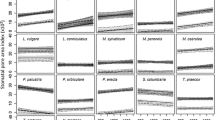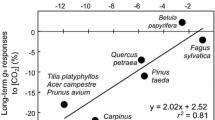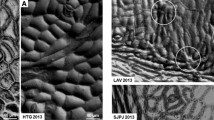Abstract
Differences in stomatal density (SD) and stomatal index (SI) are associated with the conditions of the environment in which they are distributed. Mimosa species are important elements in different plant communities, yet knowledge of the ecological implications of its stomatal characteristics is scarce. For this reason, SD and SI were determined in seven Mimosa species from different environments in this study. Five individuals per species were selected, and a sample of leaflets was obtained from each. Fifteen mature leaflets per individual were then extracted and observed by optical microscopy. SD, SI, epidermal cell density (ECD), and guard cell length (GCL) values were obtained. Differences between species were analyzed through a balanced analysis of variance test, and the correspondence between the stomatal characteristics and 21 climate variables was determined by canonical correspondence analysis. The species differed in all evaluated characteristics. It should be noted that only M. affinis showed differences between the leaflet surfaces. Both DE and ECD were negatively associated with altitude and solar radiation and positively with temperature and precipitation. SI was explained by temperature and seasonality of precipitation, and GCL by temperature oscillation and seasonality of precipitation. The results suggest that the stomatal characteristics of the leaflets confer resistance in the species to alterations in environmental conditions.






Similar content being viewed by others
Data availability
The datasets generated during and/or analysed during the current study are available from the corresponding author on reasonable request.
Change history
25 March 2024
A Correction to this paper has been published: https://doi.org/10.1007/s00709-024-01947-w
References
Aasamaa K, Sõber A (2011) Stomatal sensitivities to changes in leaf water potential, air humidity, CO2 concentration and light intensity, and the effect of abscisic acid on the sensitivities in six temperate deciduous tree species. Environ Exp Bot 71(1):72–78. https://doi.org/10.1016/j.envexpbot.2010.10.013
Agurla S, Gahir S, Munemasa S, Murata Y, Raghavendra AS (2018) Mechanism of stomatal closure in plants exposed to drought and cold stress. In: Iwaya-Inoue M, Sakurai M, Uemura M (eds) Survival strategies in extreme cold and desiccation: Adaptation mechanisms and their applications. Springer, Singapore, pp 215–232
Alvarado G, Jáuregui D, Garcia M, Alvarado H, Zambrano F (2020) Anatomía foliar de Calliandra riparia Pittier en un gradiente altitudinal de la cuenca del río Tocuyo, Lara, Venezuela. Investigatio 13:13–24. https://doi.org/10.31095/investigatio.2020.13.2
Aryavand A, Ehdaie B, Tran B, Waines JG (2003) Stomatal frequency and size differentiate ploidy levels in Aegilops neglecta. Genet Resour Crop Evol 50:175–182. https://doi.org/10.1023/A:1022941532372
Beerling DJ, Chaloner WG (1993) The impact of atmospheric CO2 and temperature change on stomatal density: observations from Quercus robur Lammas leaves. Ann Bot 71(3):231–235
Beerling DJ, Kelly CK (1997) Stomatal density responses of temperate woodland plants over the past seven decades of CO2 increase: A comparison of Salisbury (1927) with contemporary data. Am J Bot 84(11):1572–1583
Camargo-Ricalde SL, Reyes-Jaramillo I, Montaño NM (2010) Forestry insularity effect of four Mimosa L. species (Leguminosae-Mimosoideae) on soil nutrients of a Mexican semiarid ecosystem. Agrofor Syst 80:385–397. https://doi.org/10.1007/s10457-010-9330-y
Carins-Murphy MR, Jordan GJ, Brodribb TJ (2016) Cell expansion not cell differentiation predominantly co-ordinates veins and stomata within and among herbs and woody angiosperms grown under sun and shade. Ann Bot 118(6):1127–1138. https://doi.org/10.1093/aob/mcw167
Cuervo-Robayo AP, Téllez-Valdés O, Gómez-Albores MA, Venegas-Barrera CS, Manjarrez J, Martínez-Meyer E (2014) An update of high-resolution monthly climate surfaces for Mexico. Int J Climatol. 34:2427–2437. https://doi.org/10.1002/joc.3848
Dahmer N, Simon MF, Schifino-Wittmann MT, Hughes CE, Miotto STS, Giuliani JC (2011) Chromosome numbers in the genus Mimosa L.: cytotaxonomic and evolutionary implications. Plant Syst Evol 291:211–220. https://doi.org/10.1007/s00606-010-0382-2
de Boer HJ, Drake PL, Wendt E, Price CA, Schulze ED, Turner NC, Nicolle D, Veneklaas EJ (2016a) Apparent overinvestment in leaf venation relaxes leaf morphological constraints on photosynthesis in arid habitats. Plant Physiol 172:2286–2299. https://doi.org/10.1104/pp.16.01313
de Boer HJ, Price CA, Wagner-Cremer F, Dekker SC, Franks PJ, Veneklaas EJ (2016b) Optimal allocation of leaf epidermal area for gas exchange. New Phytol 210:1219–1228. https://doi.org/10.1111/nph.13929
Drake PL, Froend RH, Franks PJ (2013) Smaller, faster stomata: scaling of stomatal size, rate of response, and stomatal conductance. J Exp Bot 64(2):495–505. https://doi.org/10.1093/jxb/ers347
Drake PL, de Boer HJ, Schymanski SJ, Veneklaas EJ (2019) Two sides to every leaf: water and CO2 transport in hypostomatous and amphistomatous leaves. New Phytol 222(3):1179–1187. https://doi.org/10.1111/nph.15652
Dunlap JM, Stettler RF (2001) Variation in leaf epidermal and stomatal traits of Populus trichocarpa from two transects across the Washington Cascades. Canad J Bot 79:528–536. https://doi.org/10.1139/cjb-79-5-528
Edeoga HO, Omosun G, Osuagwu GGE, Emezue OO (2008) Micromorphology of the leaf cuticle in Mimosa species (Leguminosae-Mimosoideae). Asian J Plant Sci 7(4):424–426. https://doi.org/10.3923/ajps.2008.424.426
Flores-Cruz M, Santana-Lira HD, Koch SD, Grether R (2004) Taxonomic significance of leaflet anatomy in Mimosa series Quadrivalves (Leguminosae, Mimosoideae). Syst Bot 29(4):892–902. https://doi.org/10.1600/0363644042451099
Franks PJ, Beerling DJ (2009) Maximum leaf conductance driven by CO2 effects on stomatal size and density over geologic time. Proc Natl Acad Sci USA 106(25):10343–10347. https://doi.org/10.1073/pnas.0904209106
Ganem DG, Equiza MA, Lorenzo M, Tognetti JA (2014) Cambios en la anatomía epidérmica foliar de cereales de clima templado en respuesta al frío. Rev Fac Agron La Plata 113(2):157–164
Gay AP, Hurd RG (1975) The influence of light on stomatal density in the tomato. New Phytol 75:37–46
Grether R (2023) Mimosa. In Flora of North America Editorial Committee (eds.). Flora of North America North of Mexico. New York Oxford 11(part 1):93–104
Grether R, Camargo-Ricalde SL, Martínez-Bernal A, Montaño-Arias SA, Fraile ME (2015) Diversity and geographical distribution patterns of the genus Mimosa (Mimosoideae) in the United States, Mexico, and Central America. In: R. Fortunato (ed) V Conferencia Internacional de Leguminosas (VILC). Buenos Aires, Argentina: Fundación CICCUS. 224
Grohar MC, Rosenfeldt S, Morales M (2021) Stomatal micromorphology in a complex of Mimosa section Mimosa (Fabaceae). Protoplasma 259(1):203–215. https://doi.org/10.1007/s00709-021-01655-9
Hammer O, Harper DAT, Ryan PD (2001) PAST: paleontological statistics software package for education and data analysis. Palaeontol Electron 4(1):1–9
Haworth M, Scutt CP, Douthe C, Marino G, Gaudio GMT, Loreto F, Flexas J, Centritto M (2018) Allocation of the epidermis to stomata relates to stomatal physiological control: Stomatal factors involved in the evolutionary diversification of the angiosperms and development of amphistomaty. Environ Exp Bot 151:55–63. https://doi.org/10.1016/j.envexpbot.2018.04.010
Henry C, John GP, Pan R, Bartlett MK, Fletcher LR, Scoffoni C, Sack L (2019) A stomatal safety-efficiency trade-off constrains responses to leaf dehydration. Nat Commun https://doi.org/10.1038/s41467-019-11006-1
Hernández MP, Arambarri AM (2010) Stomatal distribution, stomatal density and daily leaf movement in Acacia aroma (Leguminosae). Bol Soc Argent Bot 45(3–4):273–284
Hetherington AM, Woodward FI (2003) The role of stomata in sensing and driving environmental change. Nature 424:901–908
Hijmans RJ, Cameron SE, Parra JL, Jones PG, Jarvis A (2005) Very high resolution interpolated climate surfaces for global land areas. Int J Climatol 25:1965–1978. https://doi.org/10.1002/joc.1276
Jordão LSB, Morim MP, Simon MF, Dutra VF, Baumgratz JFA (2021) New species of Mimosa (Leguminosae) from Brazil. Syst Bot 46(2):339–351. https://doi.org/10.1600/036364421X16231782047271
Kelly CK, Beerling DJ (1995) Plant life form, stomatal density and taxonomic relatedness: a reanalysis of Salisbury (1927). Funct Ecol 9:422–431
Lawson T, Matthews J (2020) Guard cell metabolism and stomatal function. Annu Rev Plant Biol 71(1):273–302. https://doi.org/10.1146/annurev-arplant-050718-100251
Liu C, He N, Zhang J, Li Y, Wang Q, Sack L, Yu G (2018) Variation of stomatal traits from cold temperate to tropical forests and association with water use efficiency. Funct Ecol 32:20–28. https://doi.org/10.1111/1365-2435.12973
Liu C, Sack L, Li Y, Zhang J, Yu K, Zhang Q, He N, Yu N (2023) Relationships of stomatal morphology to the environment across plant communities. Nat Commun 14:6629. https://doi.org/10.1038/s41467-023-42136-2
Luomala E-M, Laitinen K, Sutinien S, Kellomäki S, Vapaavuori E (2005) Stomatal density, anatomy and nutrient concentrations of Scots pine needles are affected by elevated CO2 and temperature. Plant Cell Environ 28:733–749. https://doi.org/10.1111/j.1365-3040.2005.01319.x
Montaño-Arias SA, Camargo-Ricalde SL, Grether R (2018) Complejos estomáticos de veinticuatro taxa de Mimosa (Leguminosae) presentes en México. Act Bot Mex 122:97–107. https://doi.org/10.21829/abm122.2018.1260
Morales M, Wulff AF, Fortunato RH, Poggio L (2014) Chromosome studies in southern species of Mimosa (Fabaceae, Mimosoideae) and their taxonomic and evolutionary inferences. Plant Syst Evol 300(5):803–817
Muir CD (2018) Light and growth form interact to shape stomatal ratio among British angiosperms. New Phytol 218:242–252. https://doi.org/10.1111/nph.14956
Naizaque J, García G, Fischer G, Melgarejo LM (2014) Relación entre la densidad estomática, la transpiración y las condiciones ambientales en feijoa (Acca sellowiana [O. Berg] Burret). Rev. U.D.C.A Act. & Div Cient 17(1):115–121. https://doi.org/10.31910/rudca.v17.n1.2014.946
NCSS 2020 Statistical Software (2020) NCSS, LLC. Kaysville, USA, ncss.com/software/ncss
Papanatsiou M, Amtmann A, Blatt MR (2016) Stomatal spacing safeguards stomatal dynamics by facilitating guard cell ion transport independent of the epidermal solute reservoir. Plant Physiol 172(1):254–263. https://doi.org/10.1104/pp.16.00850
Parshuram ZA, Harrison TL, Simonsen AK, Stinchcombe JR, Frederickson (2022) Nonsymbiotic legumes are more invasive, but only if polyploid. New Phytol. 237(3):758–765. https://doi.org/10.1111/nph.18579
Rasband WS (1997–2018) ImageJ. U. S. National Institutes of Health, Bethesda, Maryland, USA. https://imagej.nih.gov/ij/
Rivera P, Villaseñor JL, Terrazas T (2013) El aparato estomático de Asteraceae y su relación con el aumento de CO2 atmosférico en la Reserva Ecológica del Pedregal de San Ángel. México Rev Mex Biodivers 84(2):499–508. https://doi.org/10.7550/rmb.30933
Rudall P (2007) Anatomy of flowering plants: An introduction to structure and development. Cambridge University Press, Cambridge
Ruzin SA (1999) Plant microtechnique and microscopy. Oxford University Press, Oxford, New York
Rzedowski J (1978) Vegetación de México, 1st edn. Editorial Limusa S. A, México
Salisbury EJ (1927) On the causes and ecological significance of stomatal frequency, with special reference to the woodland flora. Philos Trans R Soc Lond 216(431–439):1–65. https://doi.org/10.1098/rstb.1928.0001
Sánchez-Díaz M, Aguirreolea J (2008) Transpiración y control estomático. In: Azcón-Bieto J. y Talón M. (Coordinadores). Fundamentos De Fisiología Vegetal. McGraw-Hill Interamericana de España. Universitad de Barcelona, Barcelona 41–56
Sauter B (2019) Evolutionary diversification of Mimosa and the Piptadenia Group – An example of phylogenetic biome conservatism. Dissertation. University of Zurich, Zurich
The Legume Phylogeny Working Group (LPWG) (2013) Towards a new classification system for legumes: Progress report from the International Legume Conference. S Afr J Bot 89:3–9. https://doi.org/10.1016/j.sajb.2013.07.022
The Legume Phylogeny Working Group (LPWG) (2017) A new subfamily classification of the Leguminosae based on a taxonomically comprehensive phylogeny. Taxon 66(1):44–77. https://doi.org/10.12705/661.3
Toral M, Manríquez A, Navarro-Cerrillo R, Tersia D, Naulina P (2010) Características de los estomas, densidad e índice estomático en secuoya (Sequoia sempervirens) y su variación en diferentes plantaciones de Chile. BOSQUE 31(2):157–164. https://doi.org/10.4067/S0717-92002010000200009
Torii KU (2021) Stomatal development in the context of epidermal tissues. Ann Bot 128(2):137–148. https://doi.org/10.1093/aob/mcab052
Valiente-Banuet A, Ezcurra E (1991) Shade as a cause of the association between the cactus Neobuxbaumia tetetzo and the nurse plant Mimosa luisana in the Tehuacan Valley. Mexico J Ecol 79:961–971. https://doi.org/10.2307/2261091
Vilela AE (1996) Morfología y anatomía foliar de especies Sudamericanas del género Prosopis (Leguminoseae-Mimosoideae): un enfoque adaptativo. Dissertation, Universidad de Buenos Aires. Buenos Aires, Argentina
Woodward FI, Kelly CK (1995) The influence of CO2 concentration on stomatal density. New Phytol 131(3):311–327. https://doi.org/10.1111/j.1469-8137.1995.tb03067.x
Woodward FI, Lake JA, Quick WP (2002) Stomatal development and CO2: ecological consequences. New Phytol 153(3):477–484. https://doi.org/10.1046/j.0028-646X.2001.00338.x
Xiong D, Flexas J (2020) From one side to two sides: the effects of stomatal distribution on photosynthesis. New Phytol 228:1754–1766. https://doi.org/10.1111/nph.16801
Zhao WL, Siddiq Z, Fu PL, Zhang JL, Cao KF (2017) Stable stomatal number per minor vein length indicates the coordination between leaf water supply and demand in three leguminous species. Sci Rep 7:2211. https://doi.org/10.1038/s41598-017-02448-y
Zhong M, Cerabolini BEL, Castro-Díez P, Puyravaud J-P, Cornelissen JHC (2020) Allometric co-variation of xylem and stomata across diverse woody seedlings. Plant Cell Environ 43:2301–2310. https://doi.org/10.1111/pce.13826
Acknowledgements
The first author wishes to thank the Consejo Nacional de Humanidades, Ciencias y Tecnologías (CONAHCyT, Spanish initials) for the doctoral grant (CVU 742973). He would also like to recognize the Ciencias Biológicas y de la Salud PhD program of Universidad Autónoma Metropolitana for all the support given in the conduct of this study. We also wish to recognise Patrick Weill for his excellent translation of this article into English.
Funding
The authors declare that no funds, grants, or other support were received during the preparation of this manuscript.
Author information
Authors and Affiliations
Contributions
SAM-A and MAA-R provided the samples that produced the results. SAM-A and MAA-R conceived and designed the study, processed the samples, and carried out the analysis and the interpretation of the results. MAA-R drafted the manuscript with assistance from SAM-A, RG, and TT. All authors contributed to the discussion of the results as well as the review and approval of the final manuscript.
Corresponding author
Ethics declarations
Conflicts of interest
The authors have no conflicts of interest to declare.
Additional information
Handling Editor: Peter Nick
Publisher's Note
Springer Nature remains neutral with regard to jurisdictional claims in published maps and institutional affiliations.
Supplementary Information
Below is the link to the electronic supplementary material.
Rights and permissions
Springer Nature or its licensor (e.g. a society or other partner) holds exclusive rights to this article under a publishing agreement with the author(s) or other rightsholder(s); author self-archiving of the accepted manuscript version of this article is solely governed by the terms of such publishing agreement and applicable law.
About this article
Cite this article
Ayala-Ramos, M.A., Montaño-Arias, S.A., Terrazas, T. et al. Ecological implications of stomatal density and stomatal index in the adult stage of Mimosa L. (Leguminosae, Caesalpinioideae). Protoplasma 261, 477–486 (2024). https://doi.org/10.1007/s00709-023-01909-8
Received:
Accepted:
Published:
Issue Date:
DOI: https://doi.org/10.1007/s00709-023-01909-8




